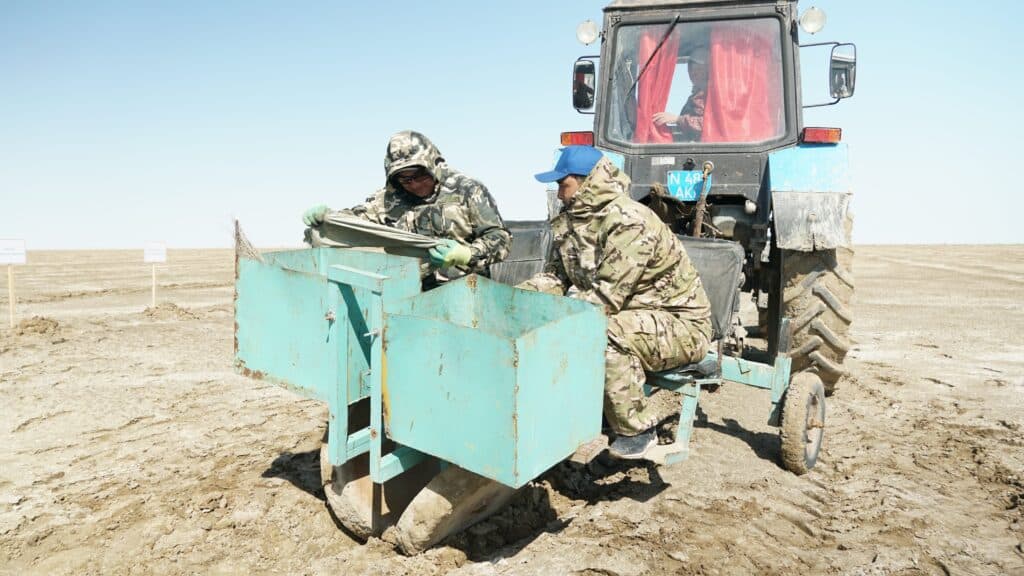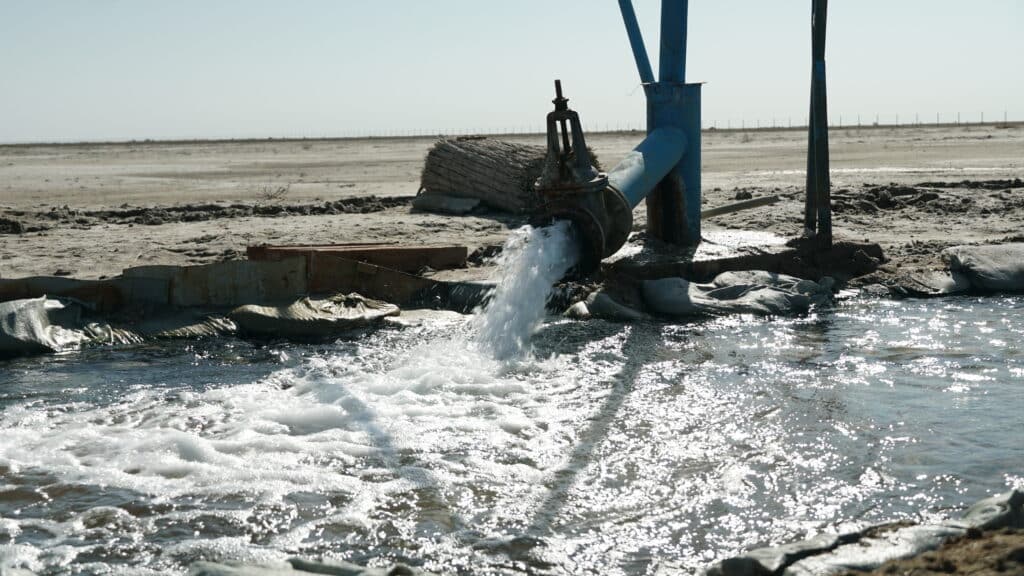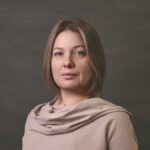How to grow a forest at the bottom of the Aral Sea

Oasis on the seabed
Wherever you looked there was nothing as far as the eye could see. As we drove along the road, all we could see from our SUV were small white stones. However, they turned out to be seashells, not stones, as we were at the bottom of the Aral Sea
Our destination was Oasis, a USAID project aimed at the restoration of an ecosystem on the bottom of the long-gone Aral Sea. The project is implemented in conjunction with the International Fund for Saving the Aral Sea (IFAS).
«The sea was 16 to 18 meters deep at the point you are standing right now,» said Zaurezh Alimbetova, deputy head of IFAS, who was waiting for us.
Under the project, environmental specialists are going to plant saxaul on a territory of 500 hectares. They have already planted about 200,000 trees on 30 parcels 200 by 250 meters each as they want to find the best way to plant saxaul (mechanized with hydrogel and without hydrogel, manual planting with hydrogel, planting root-balled trees and classic planting with watering). Aralkum, a man-made desert on the bottom of the former sea, is a tough environment even for highly resilient saxaul; two-thirds of nursery plants die after mass planting. USAID launched this project in the fall of 2021, while saxaul planting started in the spring of 2022.
«First of all, we made some furrows to accumulate some sand in them. Saxaul trees like sand and grow well if there is plenty of it,» Alimbetova said.
In 2022, there wasn’t much sand in furrows, which is why the first plating wasn’t successful and 34% of nursery trees died.
Last spring, they planted 110,000 nursery trees with a survival rate of 54%. However, later that summer the rate slipped to 47% due to severe heat.
«Even though we know that saxaul is a very strong tree, we have to water it during its first year to help it survive,» the deputy head of the IFSA noted.
To get water, the project has also tried drilling water wells but they didn’t make it through the heat last summer.
«We had expected a layer of gray-blue clay to be stop after 100 to 150 meters down, but it was 300 deep. Therefore, we could drill just 3 to 4 meters per day. That is why we started to water trees so late last year,» Alimbetova explained.
This year, the project participants planted 40,000 trees and will water them along with trees planted earlier when the heat hits.

The sole water well on the bottom of the Aral Sea is 500 meters deep. The water from the well has a temperature of 33° and a salinity of 3.8 grams per liter, which makes it suitable for watering plants. There is also a small artificial pond near the well. It feeds another drinking place for livestock and wild animals through a two-kilometer bypass canal. Since the pond has emerged, many wild birds are starting to come here. Deputy Governor of the Kyzylorda region Bakhyt Zhakhanov believes that the case with drilling water wells should be expanded throughout the bottom of the Aral Sea:
«The USAID project has shown that there is plenty of water to plant saxaul and to provide water to animals. This is why we have to expand this practice. We need more oases to speed up the forestation and to attract animals and birds to the area,» he said.
However, the restoration of biodiversity might sometimes be challenging. For instance, new shoots of saxaul are food for mice and jumping hares. To protect young trees in the oasis on the sea bottom, specialists plant saxaul by the root-balled method. Thanks to soil and weather conditions that trees are used to, this technology helps increase their survival rate and cut transportation costs.
«We worry for our plant nursery and their roots because new shoots are fresh food for mice,» Alimbetova complained.
The nursery has a fence to protect it from salt and sand, not from people or animals.
Planting saxaul and making money for planting more trees
Without plants, the bottom of the former sea poses a great danger to the entire region. There are tons of chemicals and salt on the seabed. In the past, these chemicals were used as fertilizers in rice and cotton fields across Central Asia. Then, the waters of the Amu Darya and Syr Darya Rivers brought it to the Aral Sea. Extremely inefficient use of water in the agricultural sector caused the man-made disaster which continues to collect a toll. Powerful dust storms spread dangerous particles all over the region, affecting the lives of thousands of people.
Saxaul on the bottom of the Aral Sea is meant to solve the problem. As the plant’s root system is much bigger than its crown, it works as cement for the soil around the tree.
«We cannot restore the sea, but we can apply an oasis approach by drilling water wells and planting trees. I mean, we all, Kazakhstan and Uzbekistan, are interested in the forestation of this area. We have no other choice but to do so to diminish the negative impact on us. And of course, when we talk about forestation of the seabed, we have to focus on quality, not quantity,» Alimbetova said.
The higher the saxaul survival rate, the faster this new desert will turn into a green area. So far, specialists report a 78% survival rate for root-balled nursery trees compared to the planned 50%, the IFSA deputy head highlighted.
Even though the USAID project will be completed in September, the 500-hectare parcel will continue to thrive because planted saxaul trees are expected to naturally spread their own seeds throughout the area.
The oasis may serve as a prototype for a project when funds from a donor are just a trampoline for further development. Such a project is going to be sustainable as current plantations of saxaul will facilitate further planting at the expense of carbon offsets. This means that any organization can plant root-balled saxaul, irrigate them with water from wells and get rapid results as the survival rate of these trees is quite high. In return for planting saxaul, such an organization can obtain carbon credits (for absorbing СО2) and sell them to oil-producing companies that want to offset their carbon emissions. Relying on this money, saxaul enthusiasts can continue their work and plant more trees.

Voluntary carbon certification in the Aral region is the first case in Kazakhstan. This was possible thanks to financial support from Freedom Holding Corp.
«This is a unique experience for Kazakhstan. Nobody has done something like this before in our country. Currently, we are negotiating with the Plan Vivo Foundation, an international issuer of carbon certificates, as we want them to include the Aral Oases project in their carbon project accelerator. I think we will see the certification results next year,» said Baglan Musin, president of Freedom Shapagat Corporate Foundation.
In 2023, Freedom Holding Corp. and USAID supported the IFSA pilot project aimed at planting 150 hectares of black saxaul. This year, Freedom Shapagat is going to facilitate planting black saxaul at 336 hectares along with restoring 1,000 hectares of grassland under the complex program of the Aral ecosystem restoration.
To support the project, Freedom Bank issued an Araldy Saqta card with 10% cashback, which goes to the IFSA, not the client. «This makes people feel that they are helping to solve this environmental problem along with big organizations,» highlighted CEO of Freedom Holding Corp. Timur Turlov.
«I think that this project has global significance. It is very important to keep the ecological balance and prevent dust and salt storms that can affect climate throughout the entire region. We have to use advanced technologies and methods to involve local communities and international organizations in this process. This is going to be an example of responsibility and readiness to correct mistakes made many years ago,» the businessman added.
Turlov visited the oasis in person and even planted one saxaul tree on his own.

